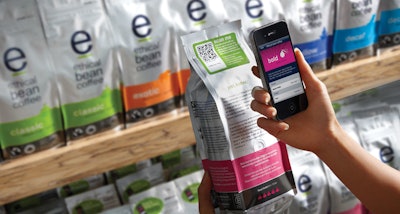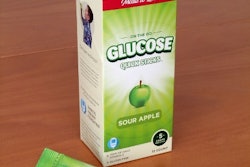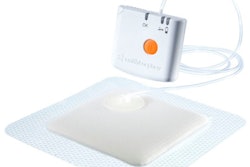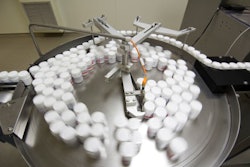First emerging as a trickle and now as a flood, mobile marketing campaigns have sprung up on the pages of newspapers and magazines, on billboards and in kiosks, and on point-of-purchase retail displays and packaging across the country.
According to a study by comScore, in June alone, 14 million mobile device users in the U.S.— or 6% of the total mobile audience— scanned a Quick Response code. While newspapers and magazines were the most scanned mediums, packaging came in second, at 35.3%.
And the rate of growth in code-scanning traffic is remarkable. Reports Mobile Marketing on a recent Scanbuy survey, "Bar-code scanning traffic increased more than 800 percent year-over-year [from Jan. 1 to March 31], proving that consumers are willing to participate in promotions that are based on this technology."
For consumer packaged goods companies, on-pack mobile marketing offers an unprecedented opportunity to connect with consumers at the point of purchase and beyond. As marketers are learning, however, the effectiveness of mobile marketing tools to enhance brand loyalty, actively engage consumers, and drive repeat purchases is ultimately dependent on the value and creativity of the content provided.
This article explores four examples of CPGs that have successfully leveraged a range of on-pack mobile marketing technologies to add excitement and relevance to their brands and to drive increased sales.
Homegrown QR code program lends quality seal to coffee
When Ethical Bean Coffee Co. set out to redesign its product packaging two years ago, it was searching for an uncluttered, striking design that also offered flexibility for product labeling. The Vancouver, BC, Canada-based coffee maker uses only Fair Trade-certified, organic coffee beans, roasted in various combinations to produce eight product varieties, ranging from Mellow to Rocket Fuel.
"We wanted to have more flexibility in what we put in the packaging," says Lloyd Bernhardt, founder and CEO of Ethical Bean. "We wanted to be able to change the ingredient lists in real-time on-the-fly so that we could buy the best Fair Trade and organic coffees. As long as they fit our flavor profiles, we are happy."
The company also wanted to provide a new level of transparency on their coffee blends and roasting processes to consumers. The company considered the use of UPC codes, but found they were too "static," says Berhardt. "We also were concerned that they would cause confusion at the register," he adds.
Coming from a technology background, Bernhardt led the in-house development of a system that comprised an internal database that could be linked with batch-specific QR code labels, printed on-demand. "It forced us to formalize a lot of our systems," he says. "Every time we touch coffee, every attribute is captured in our internal database."
For each batch of coffee roasted at Ethical Bean, a unique QR code is created and printed on a label that is then adhered to the bag during the manual packaging process. The code allows consumers to access a wealth of information on that specific batch, including the coffee blend, when and where the beans were harvested, the roast profile, the roast graph, cupping notes and videos, and certifications. In some cases, Ethical Bean offers additional photos and videos of the coffee co-ops from which the beans were sourced. Consumers are also introduced to the individual at Ethical Bean who roasted their batch, through a picture and fun personal profile.
The QR code can be accessed in three ways: through a free Ethical Bean iPhone app, through third-party QR code readers, or by going to the company's Web site and typing in the lot number, which is printed below the QR code on the label— making the information available to consumers regardless of their access to a smartphone.
Since it was launched in June 2010, the new bag with "emark," as it is referred to by Ethical Bean, has seen a "fairly good scan conversion rate— sometimes up to 8% per month," relates Bernhardt. Coffee sales have also increased by 30% over the previous year, he adds, although he says he cannot directly attribute the gains to the addition of the QR code.
"What we have found is that the QR code is like a quality seal," Bernhardt reflects. "Since we are being so transparent and telling the customer absolutely everything we are doing, they get a sense of trust."
With the addition of a new packaging line at its plant, Ethical Bean will soon be printing QR codes directly onto the packaging in-line. Bernhardt says he envisions future iterations of the QR program to allow consumers to actively communicate with co-ops and coffee roasters, keep a history of their scans, and participate in loyalty programs. "It's nice to be able to give the consumer more information," he says, "but financial incentives are also important."
2D matrix codes for berries support food-safety efforts
Family owned and operated, Driscoll's of Watsonville, CA, is a leading global supplier of berries. Backed by more than 100 years of farming heritage, the company's strawberries, blackberries, raspberries, and blueberries are produced by approximately 500 independent farmers throughout the world, in growing regions carefully selected for their soil, climate, and other environmental factors.
Driscoll's holds itself to the highest standards of care when it comes to growing, harvesting and shipping its berries. A key component of its brand strategy is a continuous focus on delivering the highest level of food safety through Good Agriculture Practices (GAP) set by the U.S. Food and Drug Administration. The effort is uniformly enforced at all of its farms, and at its cooling and distribution facilities around the world.
But controlling what happens from the field to the grocery store addresses only one side of the consumer-confidence equation. Driscoll's also wanted a way to create a stronger connection between its berries and consumers by making it possible for the consumer to trace their berries back to where they were grown.
Under Driscoll's "Follow Us To The Farm" track-and-trace program, berries are packaged in clear clamshell containers with a prime label on the lid and a UPC label on the bottom on which is printed a variable 2D matrix code and a corresponding human-readable alphanumeric tracking code. The codes allow consumers to learn where their berries were harvested, by either entering the alphanumeric code at the company's Web site or through the use of a downloadable iPhone application, HarvestMark Food Traceability, which takes a photo of the 2D matrix code and brings the consumer directly to information on the growing region.
The system, developed by YottaMark, Inc., was launched in February 2009 and has been used for hundreds of millions of traceable labels for 35 of Driscoll's SKUs since that time. Site content at "Follow Us To The Farm" provides consumers with information about the growing region of their berries, the name of the farm, and access to farmer profiles, which are routinely updated.
"We continue to rapidly expand the level of product coverage with traceable packages," says Doug Ronan, vice president of marketing for Driscoll's. "Our ultimate goal is to have every Driscoll's clamshell traceable to individual farms. The tracking code is a great invitation for berry lovers to learn more about the story of their favorite Driscoll's berry, and it enhances our procedures for meeting global food safety standards.
"Overall, this program gives consumers confidence and peace of mind knowing they can easily access information about their purchase. And the track-and-trace features of the bottom label have been added at no extra cost to consumers."
The biggest challenges of the project, however, are ensuring that every code-tracking label is 100% scannable and that Driscoll's knows which labels have been sent to which farm. To ensure readability, label supplier WS Packaging uses an on-press camera scanning system that confirms scan ability of every 2D code and ensures the label is accurately printed. The bottom label, made from Fasson® Semi-Gloss Eliteâ pressure-sensitive paper from Avery Dennison, http://www.averydennison.com is flexo-printed in one press pass with the UPC, 2D matrix, and human-readable alphanumeric codes in one color. The label is variable image-printed with a drop-on-demand ink-jet print system and is coated with a UV varnish to protect it during shipping and handling. Labels are applied to clamshells by the thermoformers, who then sell Driscoll's the cases of labeled clamshell containers.
At Driscoll's, strawberries, blackberries, and raspberries are packed in the field, while blueberries are handled in a packing facility. To allow Driscoll's to identify which containers are sent to which farms, when the clamshells are cased by the thermoformer, each case is labeled with a "master case" label having removal "daughter tag" labels. The 2D code on each clamshell is scanned and recorded as they are put into the case. A unique code is then assigned to the scannable master case label and daughter tags and associated to the individual clamshells. This computer-controlled process establishes a connection between what has been scanned, what is in each case and, ultimately, where each case ends up. WS Packaging also produces the master case labels.
When a case of clamshells goes to a farm, berry pickers remove the clamshells from the case, and the daughter tag is taken off the case and placed on a special form and scanned. It's at this point that Driscoll's knows which case, and its corresponding clamshells, is in that field on that day. When every daughter tag is collected and scanned, Driscoll's knows what was picked and from which field it was harvested.
Icon-based tags used by Wrigley to engage and delight
As indicated by the previous two examples, QR codes have become one of the most popular tools for mobile marketers. But there are alternative technologies. In recent promotions involving two of its gum brands, Wm. Wrigley Jr. Co. chose SnapTagâ„¢ technology from SpyderLynk, http://www.spyderlynk.com to "give consumers more than just a piece of gum," says the company.
The SnapTag is a logo-centric code that can be activated by consumers using any smart or standard camera phone. "SpyderLynk SnapTags offer a truly unique opportunity to influence loyalty and repeat-purchase decisions," says Jennifer Jackson of Wrigley marketing communications. "Wrigley looked at different solutions and felt that SnapTag technology offered the most sophisticated marketing capabilities and analytics tools, and provided an easy way for consumers to interact with Wrigley."
For one promotion, the Orbit Bucks Back-to-School Campaign, which runs from July through October 2011, Wrigley printed 100 million packs of Orbit gum with one of 30 different back-to-school icons, such as flip-flops, backpacks, sneakers, and more. To participate in the promotion, mobile consumers snap a picture of the SmartTag and send it to a text number to unlock prize points, called Orbit Bucks, that can be cashed in for back-to-school themed prizes. For smartphone users, SpyderLynk also offers a free code-scanning app that can be used to activate the icon.
The Orbit SnapTag is located on the inside flap of the gum pack, with messaging printed on the outer film wrapper that says, "Text and you could instantly win Orbit bucks." Wrigley relates that because the graphics and language on its packaging change frequently, creating the packaging for the SnapTag promotion was seamless.
The second promotion— a surprise feature on 3 million Juicy Fruit packs, available from August to October 2011— was designed by Wrigley to "entertain and fascinate viewers." When consumers open the gum pack, a SnapTag featuring a unicorn icon reveals an exclusive video of Juicy Fruit's popular online Serenading Unicorn, which made its debut last spring. "It's like a thank-you song for purchasing the gum," says SpyderLynk founder and CEO Nicole Skogg.
From a technical standpoint, the SnapTag system recognizes both the icon and the code ring printed around the icon. For the Orbit promotion, all varieties of the SnapTag link back to the same promotion. Just one SnapTag is used for the Juicy Fruit Serenading Unicorn pack. Analytics gathered by SpyderLynk advise Wrigley on the location in which a tag is being snapped, when it's snapped, and whether a consumer snaps more than one icon. "We can look at snaps by the time of day and by the day of week, so we can give Wrigley interesting insights on when people are engaging," says Skogg. "That could help them in the future if they want to think about different ways of messaging at different time periods."
Says Jackson, "While the consumer response is still being measured, we believe interactive packaging is emerging as an important channel for connecting with consumers in a more meaningful way."
As of late August, Skogg reported that the Orbit promotion was gaining momentum. "Week-over-week, we are seeing growth in the level of engagement," she noted. "It seems like the campaign is definitely picking up and growing."
Central Garden lets pack act as gateway to mobile
Perhaps the least well recognized of the technologies, but no less intriguing, is a system that relies on image recognition technology. In March 2011, Walnut Creek, CA-based Central Garden & Pet launched a promotion for its Pennington Ultimate Grass Seed product that allows consumers to link to a free lawn guide by snapping a picture with any camera-enabled mobile phone of the grass seed package itself and forwarding it by text or e-mail.
"Research shows that buying and growing grass seed and maintaining your lawn is complicated," says Brenda Riney, director of customer marketing – Walmart & Sam's Club Team, for Central Garden & Pet. "Central Garden wants to simplify the process and make it easier for our consumers to be successful with their yard."
After reviewing the "features, capabilities, and limitations" for all of the top mobile technologies, Riney says Central Garden and its digital agency, IQ, http://www.iqagency.com selected image recognition software from Mobius for the following reasons:
-
It works on all camera cell phones with any carrier globally
-
No codes or tags that could clutter artwork are required
-
There are no apps to download
-
The content is very cell phone-friendly (formatted for 99% of mobile phones)
-
It shares consumer insights via an easy-to-read dashboard
-
It recognizes images better than competing image-recognition software
In conjunction with an aggressive TV and radio campaign called Smart Seed for its Pennington brand grass seed last spring, Central Garden applied stickers to its 15-lb bags of Ultimate grass seed— sold in Sam's Club and Walmart stores— that advised consumers through copy and icons to "snap," "send," and "receive." The content delivered in response includes a free lawn guide, video planting tips, information on other Central Garden products, and other content specifically designed for mobile users.
Riney says content can be changed on-the-fly by Central Pet as results from the mobile campaign are analyzed. A Mobius dashboard provides the company with individual consumer data that includes cell phone number, location, type of cell phone used, carrier, and interactions by date and time of day. To change content, Central Pet sets up the response and formats the information for 50 types of formats that work for more than 500 types of cell phone hardware. Says Riney, it's an "overnight process."
Since Pennington Ultimate Grass Seed was launched with the mobile promotion, Riney says the brand has been very successful. "Consumers love the extra info on their cell phone," she says. "Mobile marketing is in its infancy, but it's growing exponentially."
Background information for this article was compiled with the help of Tom Vierhile, innovation insights director for Datamonitor.



























